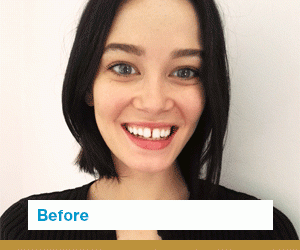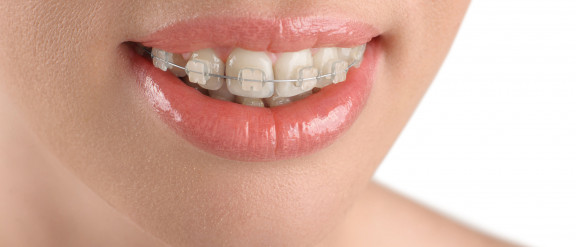
Everything you've ever wanted to know about Fixed Braces
Adult braces, it seems, are as popular these days as a tattoo or two, a pair of designer glasses and teeth whitening.
Celebrity smiles are inspiring many of us to see a new smile and, when it comes to our overall appearance, straight teeth matter.
Indeed, whether it is a social occasion or a job interview, our smile is one of the first things others notice about us and can have a major effect on meaningful personal interactions.
With the days of our only option being heavy metal brackets and wires or so-called ‘train tracks’ long gone, orthodontic treatments seem ever expanding.
A dazzling smile has never been so en vogue or so easily attained.
So, what exactly are our options for Fixed Adult Braces?
There are many systems out there to suit all pockets and correct all manner of misalignment issues.
If you have more complex problems with your teeth – severe overcrowding, gaps and complex malocclusion issues where teeth don’t sit right when you bite down, chances are you will require orthodontic treatment designed specifically to address these issues.
Generally, the more complex the problem, the longer orthodontic treatment might take.
At the other end of the scale are the more simple issues with wonky front teeth or a tooth that hides behind the others and is out of line. The front teeth that show when you smile – also know as the ‘social six’ – can be dealt with by braces aimed at straightforward realignment.
The other factor you may wish to consider is just how discreet you want your braces – and what advantages there are if they are removable.
For those of us who are a little slapdash or commitment-phobic, fixed braces may be a better choice. With the opportunity to remove braces, it can be tempting to conveniently forget to pop them back in.

Fixed braces come in many guises – lingual (placed behind the teeth), ceramic tooth-coloured brackets and wires.
Ceramic fixed braces are tooth-coloured brackets that blend in with your own teeth colour, resulting in virtually invisible braces. By using low profile brackets and innovative injection-moulding technology, ceramic braces aim to create the greatest amount of comfort. Ceramic braces provide a smooth surface to ensure your mouth slides over each bracket and doesn't get caught on anything.
Ordinarily, orthodontic treatment with these braces can take anything from 18 months to three years. You will need to go for orthodontic check ups every 4-8 weeks to ensure that everything is going well and your treatment finishes on time. Usually speech is not affected but your condition may require an expander appliance to be fitted in the roof of your mouth that can interfere with the way you speak.
We need to be especially fastidious (and extra careful) about interdental cleaning – brackets and wires are vulnerable to any heavy handedness so do speak with your orthodontist or their dental nurse about how best to approach your oral hygiene regime. There is a whole toolkit available to brace wearers when it comes to keeping the mouth clean.
Additionally, we need to be selective in what we eat and drink – avoiding anything that stains or hard foodstuff is a given, but what else do we need to consider when it comes to braces, diet and improving our chances of improving the aesthetics of our smile?
Comparethetreatment expert and orthodontist Runa Mowla-Copley says:
‘Braces not only straighten teeth to create a more attractive appearance but also make for a healthier mouth. Aligned teeth are easier to keep clean and a healthy bite can protect our teeth from damage. Braces also help prevent tooth decay and other oral health problems.
‘However, looking after your fixed brace is important, especially if you have a fixed brace. Excellent oral hygiene combined with healthy eating habits will give you the healthiest smile.
‘If you are following a balanced, healthy diet you can eat most foods the way you did before braces. There are certain foods that can damage or loosen your brace.’
Runa’s top tips for healthy eating habits whilst wearing fixed braces are:
• Avoid foods, snacks and drinks that are high in sugar
• Avoid foods that require excessive chewing (sticky foods, chewing gum and avoid hard foods (nuts, popcorn, French bread)
• Avoid fizzy drinks – even the sugar-free options. Fizzy drinks are very acidic and can cause erosion of the enamel
• Sticky, hard foods can break your brace, frequent breakages can sometimes mean your treatment may take a little longer.
She says: ‘The good news is that by making certain modifications to your food – chopping up hard foods like apples into small pieces or steaming carrots, for instance – you can continue to enjoy most food.’
Award-winning London orthodontist Dr Neil Counihan runs Metamorphosis Orthodontics that specialises in improving the aesthetics and health of our teeth, he says:
‘I tell my patients that, with fixed braces, brushing is now more important than ever. Be sure to concentrate on the area between the braces and the gums. This is where the plaque collects and will cause unsightly staining if not regularly removed. Please remember that it is the invisible plaque that causes the trouble – and not food that you can see in your braces.’
And he believes that, by sticking to a few basic (but necessary) rules, anyone having adult orthodontic treatment can easily achieve the smile they've been looking for.
‘In between meals, any food that contains sugar (natural or added) should be strictly avoided! Hard foods should be eaten with great care as they will damage or break the appliance. In general, keep objects such as pens, pencils, and fingernails out of the mouth.
‘You will need to stick to very soft food for the first three to four days due to the teeth feeling tender but, after that and throughout the treatment, it's best to avoid anything very hard or sticky. Cut things up into smaller pieces and chew towards the back to avoid biting directly into hard things.
‘The wrong types of food, or eating the right kinds of food improperly, can cause food to get caught in your braces, stick to braces, loosen braces or bend wires. So, the rule is refrain from eating hard, chewy or sticky foods.’

The following is a list of common foods to avoid:
• Ice
• Corn on the cob
• Whole apples (slice them)
• Biting meat off ribs (cut meat off bone)
• Cereals with nuts/granola
• Popcorn (because unpopped kernels and husks stick in gums and breaks brackets)
• Hard lollies
• Toffee
• Nuts (including peanuts)
• Baguettes and hard rolls
• Doritos
• Pretzels
• Chewing gum (can distort wires)
• Any whole, hard fruit or raw veggies (make sure you cut it first)
• Pizza crusts.
If you're not sure whether or not Fixed Braces are for you then check out our complete guide to Invisible & Removable Braces to compare the Pros & Cons of each treatment option.
Want to find an Invisalign Provider in your area? Just use Invisalign's Find a Provider function here >
Visualise your new smile with Invisalign's Smile Visualiser here >
Related Treatments

Ceramic Fixed Braces
Ceramic braces are braces that are fixed to the te...

Fixed Braces
Fixed braces are the most common type of orthodont...

Lingual Braces
These devices are almost the same as fixed wire br...
